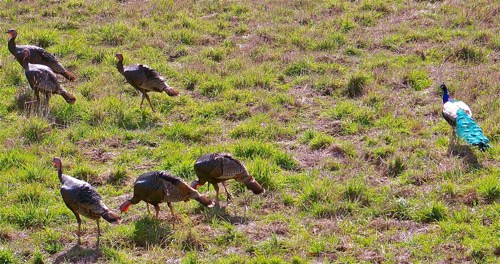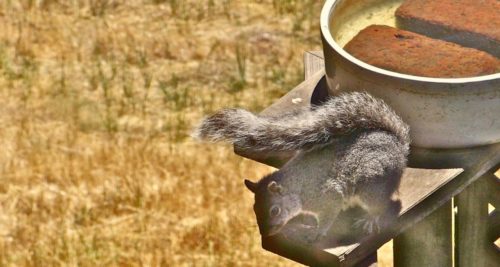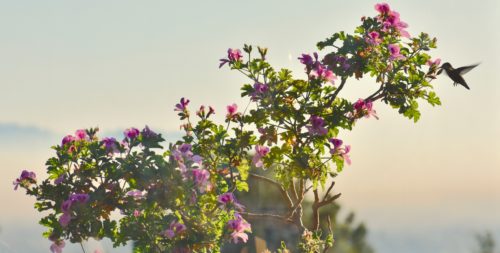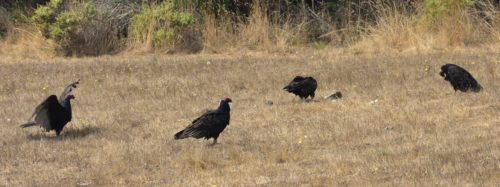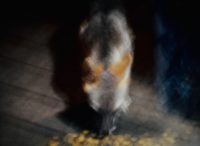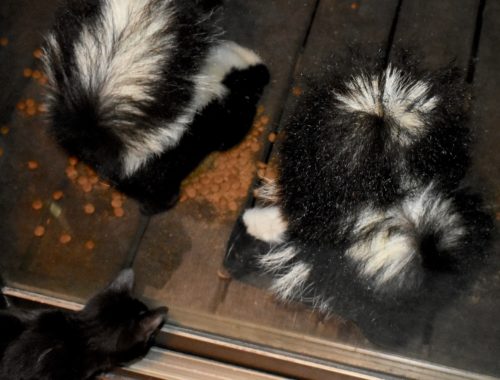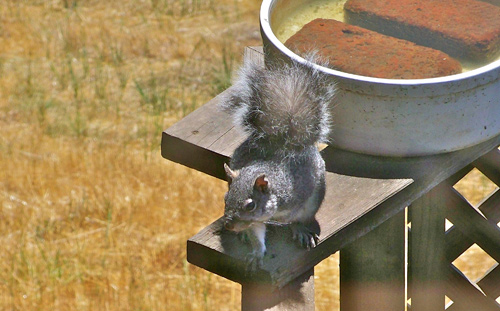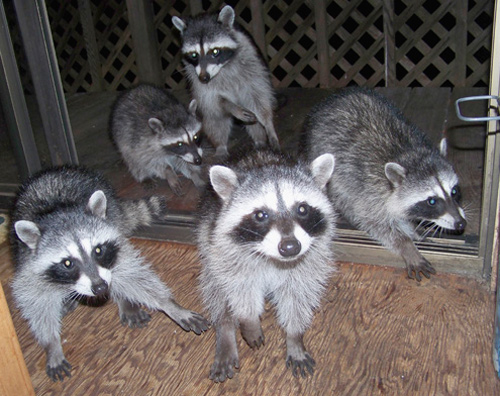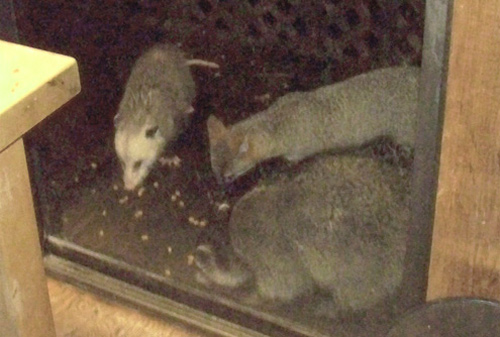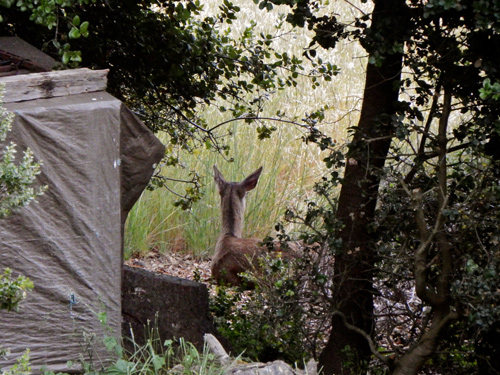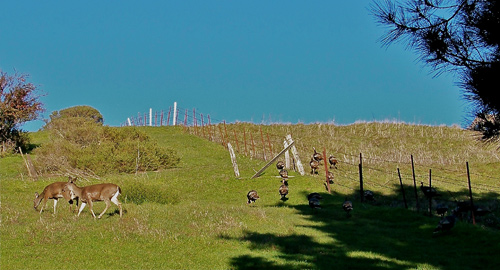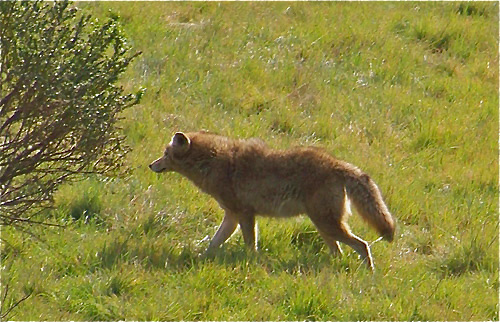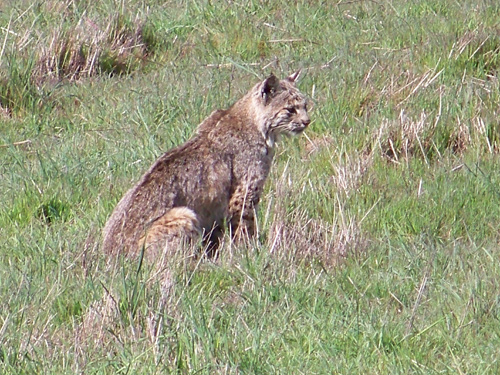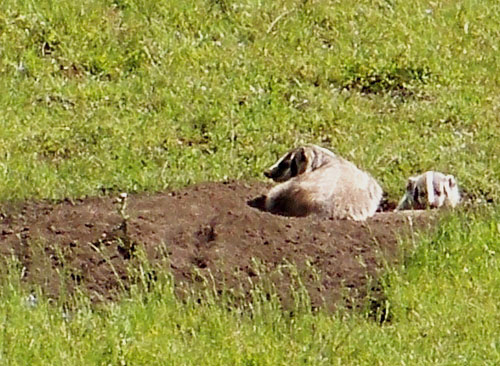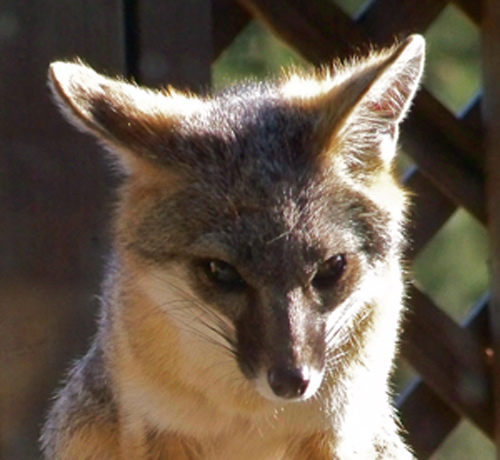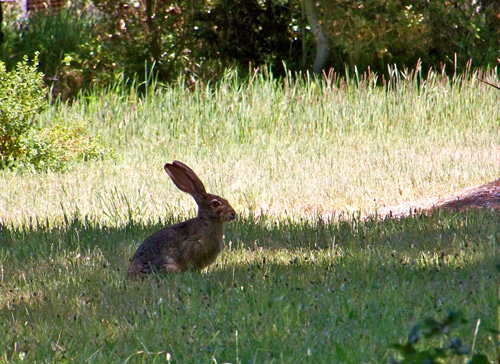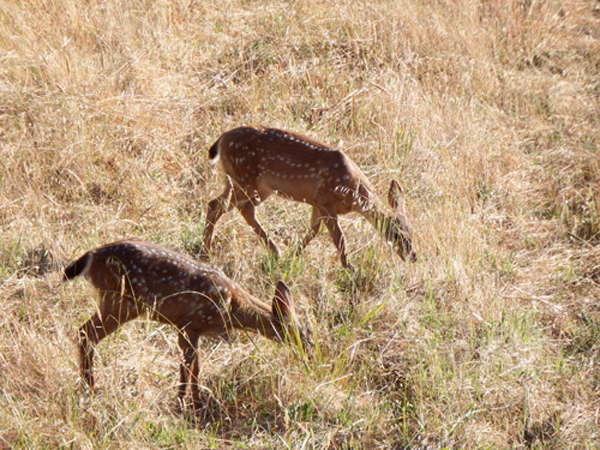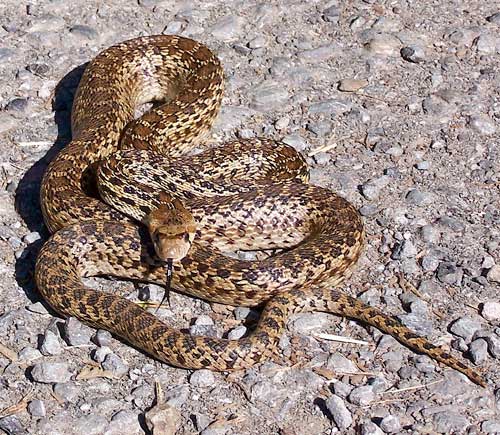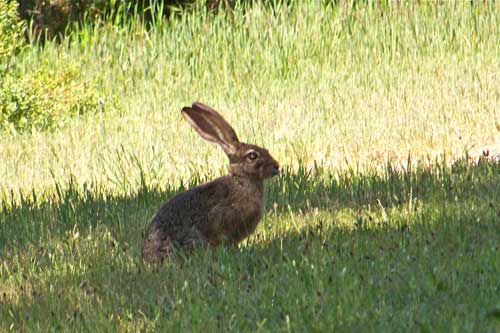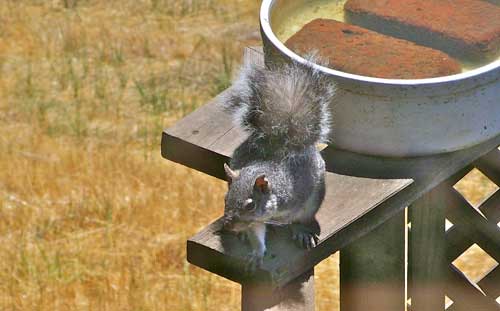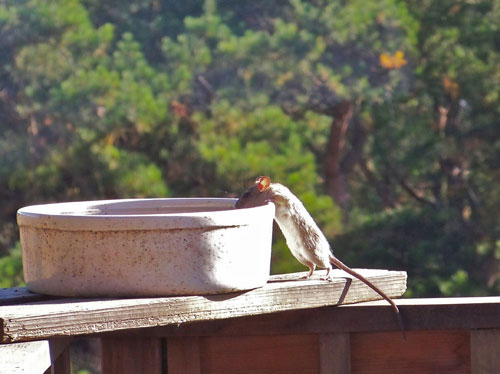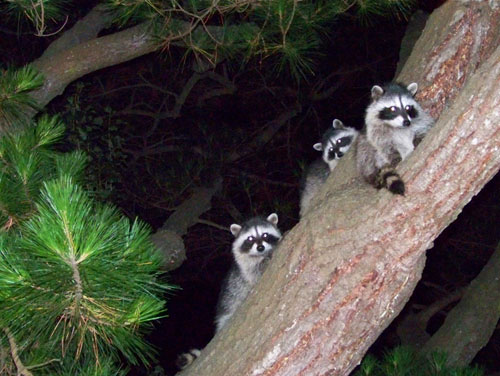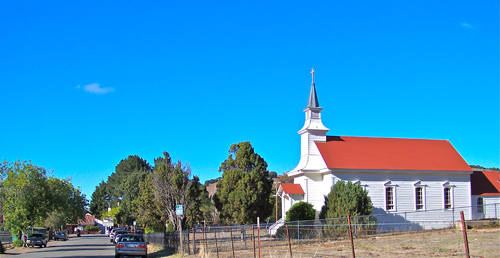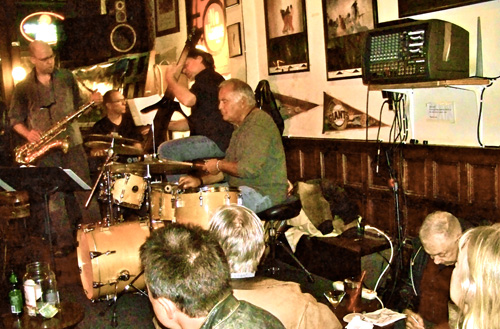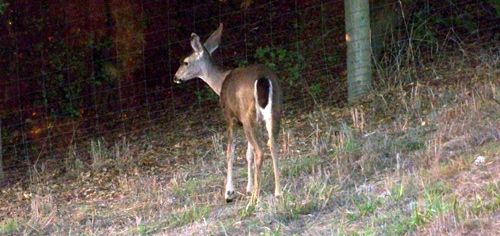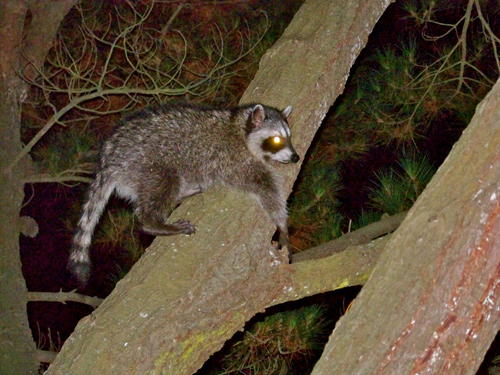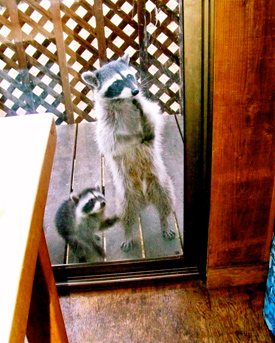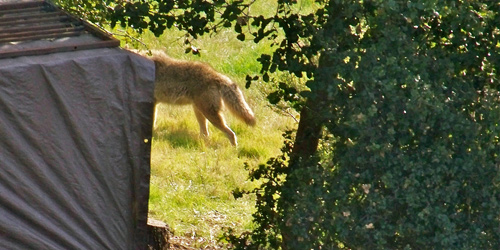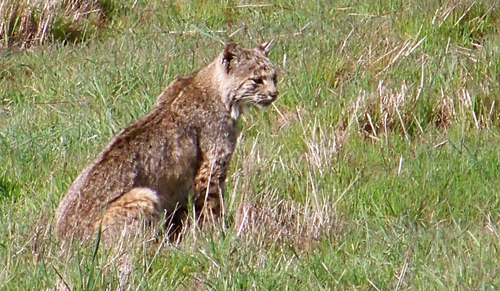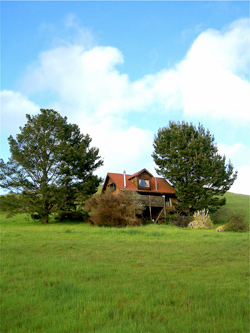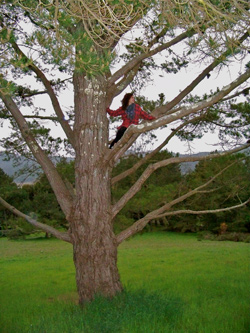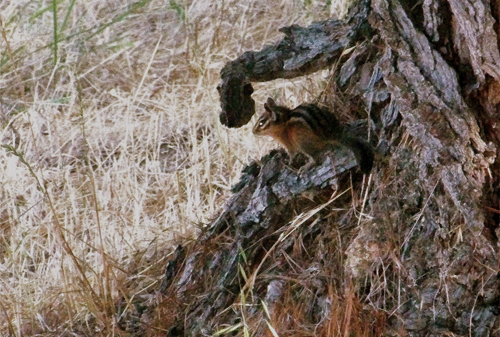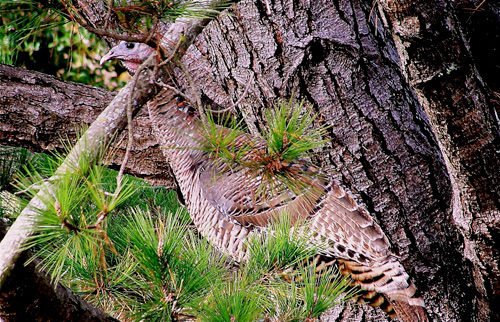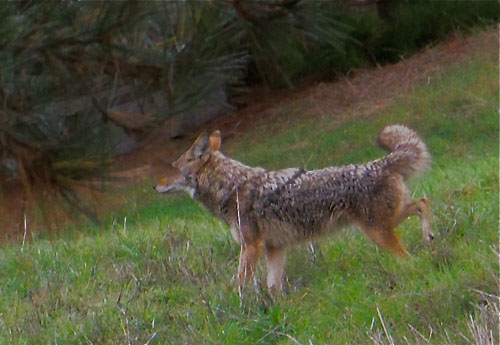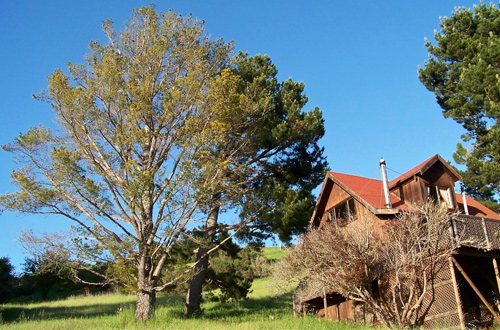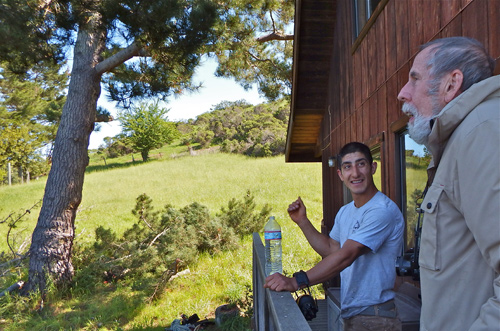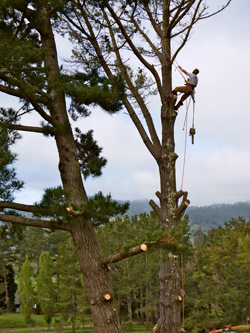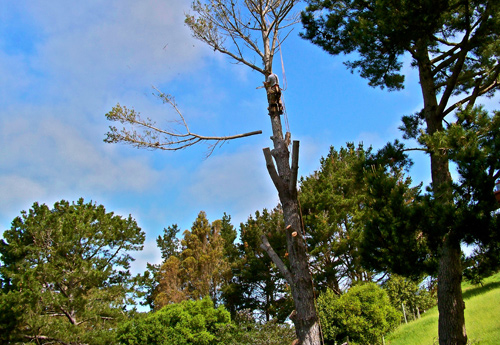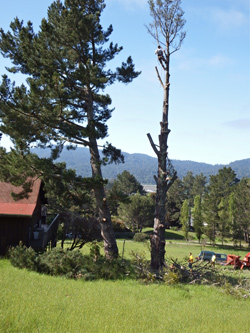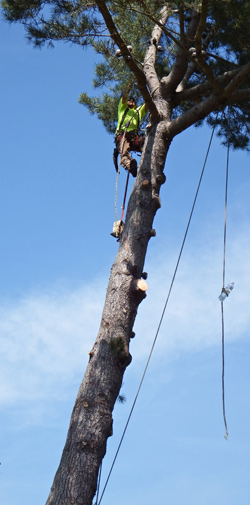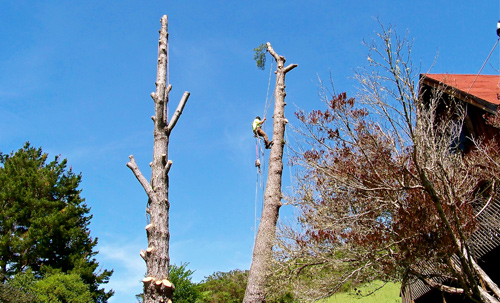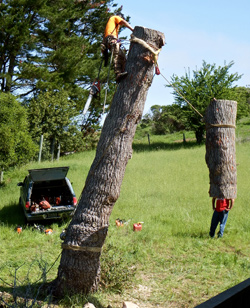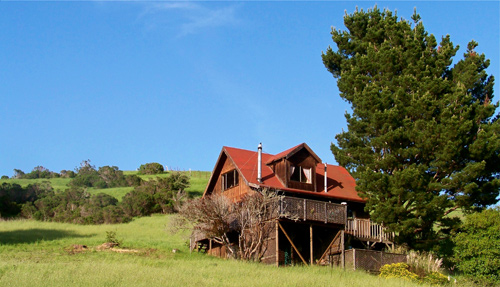Entries tagged with “coyote”.
Did you find what you wanted?
Wed 16 Jun 2021
Posted by DavidMitchell under Uncategorized
Comments Off on Wild times continued during the lockdown
Caveat lectorem: When readers submit comments, they are asked if they want to receive an email alert with a link to new postings on this blog. A number of people have said they do. Thank you. The link is created the moment a posting goes online. Readers who find their way here through that link can see an updated version by simply clicking on the headline above the posting.
My wife Lynn dealt with the tedium of the shelter-in-place lockdown in part by watching British murder mysteries in the evening. I myself seldom watch TV and instead endured the lockdown by watching the wildlife around Mitchell cabin. Here’s what I’ve been seeing.

A raccoon and a gray fox got together for an ecumenical dinner outside our kitchen door Monday night. Raccoons can be aggressive when other raccoons try to horn in on their kibble snacks, but foxes and skunks get a free pass.

Wild turkeys are regular visitors to our fields, often accompanied by a lonely peacock whose screams sound like a woman crying out for help.

A stinky trio, three skunks march around the field above Mitchell cabin in tight formation.

Jackrabbits are showing up more as summer approaches.

A squirrel stops by our birdbath for a drink.

A roof rat and towhee have an ecumenical dinner of their own, quietly snacking on birdseed atop our picnic table.

The local bobcat walked downhill toward Lynn Monday while she was transplanting nasturtiums in our garden. When the bobcat saw her, it didn’t abruptly flee but merely trotted off into a neighboring field. My homeless friend, Billy Hobbs, tells of having an unconcerned bobcat walk quite close to him while he was sleeping along Papermill Creek near the Green Bridge. “I’ll bet it’s the same one,” he said Tuesday when I told him of Lynn’s encounter. (For the moment, Billy is being housed in Motel 6 at county expense.)

Other predators that keep us company are coyotes who howl for our entertainment more nights than not.
During the pandemic lockdown, enough people were staying at home that coyotes began more freely wandering about in nearby San Francisco, with experts estimating there are 40 to 70 of them.
Mon 21 Sep 2020
Posted by DavidMitchell under Point Reyes National Seashore, West Marin nature, Wildlife
Comments Off on Home sometimes seems like an animal shelter
Caveat lectorem: When readers submit comments, they are asked if they want to receive an email alert with a link to new postings on this blog. A number of people have said they do. Thank you. The link is created the moment a posting goes online. Readers who find their way here through that link can see an updated version by simply clicking on the headline above the posting. All other readers already have an updated version.
Sheltering in place with only limited socializing definitely affects one’s thinking. It forces many of us to spend more time alone taking stock of ourselves and of our lives. It’s a humbling experience and may provide an inkling of why a prisoner behind bars cannot avoid thinking about his life. But, as I’m sure the prisoner knows, too much such thinking becomes tedious. For the moment, I’m trying to divert my attention to the creatures I find all around me.

A hummingbird a week ago enjoyed a few sips before the smoke from the Woodward Fire significantly dissipated. As of this writing, the fire, which a lightning strike started on Aug. 18, was 97 percent contained, having blackened 4,929 acres in the Point Reyes National Seashore.

A coyote wandered up to the greenhouse of neighbors Dan and Mary Huntsman on August 21. Had I been looking out my living-room window, this is what I would have seen. Alas, I wasn’t looking, but Dan was and from his home took this picture. (Photo by Dan Huntsman)

Buzzards on Sept. 13 feast on the carcass of a skunk presumably killed by a great horned owl. It was the second time in recent weeks buzzards dined on a skunk near Mitchell cabin.

A gray fox showed up on our deck after dark last week to dine on the last bits of kibble I had given some raccoons earlier.

A skunk goes eye to eye with Newy, the stray cat we adopted in late July. More frequently than the fox, skunks show up after the raccoons to pick through what remains of the kibble.
And in a weather vein: Whenever Lynn opened the bedroom window in recent days, I started sneezing and then coughing. “Do you think it’s pollen or smoke that’s causing the sneezing?” she asked me a couple of days ago. “The answer,” I told her, “is blowing in the wind.”
I’ll stop here. There’s a lot I’m tempted to write about our political situation, but I think I’ll save that for another week.
Sun 21 Jun 2015
A year ago I was hit with a medical problem called temporal arteritis, which sent me to the emergency room at Kaiser Hospital in Terra Linda. As I wrote here at that time, it was a big headache, but left untreated it could have led to blindness.
Temporal arteritis amounts to inflammation of an artery that goes through the temples (hence the name ‘temporal’) and feeds blood to the eyes. The problem is common enough that rheumatologists have developed a standard treatment using the steroid Prednisone. The cause of temporal arteritis is unknown, but it mostly hits us older folks.
Well, the Prednisone worked in that it took away the headache, but I had to consume it every day, and that itself produced temporary problems ranging from less-focused thinking to a loss of balance. I began taking increasingly serious falls. The worst was on Memorial Day when I fell to the ground from a standing position. I landed on stainless-steel metal and badly bruised the right side of my ribcage.
I had just about recovered from that fall when today I stumbled on my deck and landed on the left side of my rib cage. What a pain! As a result, I’m taking it easy on myself, which is why my posting this week consists of photos from my collection, not ruminations. Most of them have appeared here previously.

Gray squirrel at my birdbath.

The raccoons around Mitchell cabin are amazingly adventurous. These walked right in when I left the kitchen door open.

Three animals who seldom hang out together in nature, a possum, fox, and raccoon, were convinced to eat peaceably together when I scattered honey-roasted peanuts on my deck. Animal populations, however, go up and down, and I haven’t seen many foxes or possums around Mitchell cabin recently.

A blacktail doe takes a rest behind my woodshed.

Two does and a flock of wild turkeys forage side by side uphill from Mitchell cabin, both species seeming oblivious of the other.

Two years ago, a lone peacock began keeping company with the turkeys. It’s pretty but its calls sound like a woman in distress.

Coyotes can often be heard at night howling around Mitchell cabin. Getting a chance to see one is far less common.

It’s far more common to see bobcats. Here one takes a rest while hunting downhill from the cabin.

A mother badger with her kit. The most ferocious predators near the cabin are badgers. Even a bear would be no match. Badgers live in burrows up to 30 feet long and 10 feet deep, for they are remarkably efficient diggers thanks to long claws and short, strong legs. Although they can run up to 17 or 18 mph for short distances, they generally hunt by digging fast enough to pursue rodents into their burrows.

Lost in thought, a gray fix sits on my picnic table.

Jackrabbits, of course, are always around. Jackrabbits, which are also known as black-tailed hares, avoid predators by using “an element of surprise and escape that works well,” Point Reyes Station naturalist Jules Evens notes in his Natural History of the Point Reyes Peninsula.
“When a potential predator is detected, the hare will usually take shelter in the shade of a convenient clump of vegetation or behind a rock and freeze motionless. If the predator approaches very closely, the hare leaps into stride, zigzagging across open country until it finds shelter.”

Two young does graze beside Mitchell cabin. To me all this is my home on a hill, but it could just as easily be a zoological garden.
Tags: badgers, blacktail deer, bobat, coyote, fox, gray squirre, jackrabbit, peacock, possum, raccoons, wild turkeys
Mon 5 Jan 2015
Posted by DavidMitchell under West Marin nature, Wildlife
Comments Off on A gallery of the critters around Mitchell cabin
 Around the first of the year I sometimes post a roundup of the creatures that have shown up around Mitchell cabin.
Around the first of the year I sometimes post a roundup of the creatures that have shown up around Mitchell cabin.
This year I’m doing it again, starting with a butterfly and dragonfly followed by a variety of larger critters.
This exhibit ends with a coyote, a bobcat, two badgers, and two deer rubbing noses.
Regular readers of this blog will recognize some of these photos from past postings.
Here a buckeye butterfly rests on a chrysanthemum that’s growing in a flowerpot on the deck. ___________________________________________________________________

A dragonfly pauses on the twig of a tree that’s next to the deck. Dragonflies can easily be distinguished from damselflies because when they are at rest they leave their wings extended while damselflies close their wings over their bodies when at rest. __________________________________________________________________
 A Pacific tree frog on a bamboo shoot near our hot tub.
A Pacific tree frog on a bamboo shoot near our hot tub.
Some people call them Pacific chorus frogs. During the winter, their main mating season, males make their way to water and then charm females to the water with a chorus of chirping.
________________________________________________________________

Gopher snakes are not poisonous, but they mimic rattlesnakes, coiling up and wagging their tongues when threatened. This one was near the foot of our driveway.

A jackrabbit in the field outside our kitchen window pauses to look around .

This is the only chipmunk I’ve ever seen around Mitchell cabin. I’m just glad I had my camera nearby when it showed up.

A Western gray squirrel basks in the sun after taking a drink from our birdbath.

A roof rat takes a drink from the birdbath. These rats originated in southern Asia, and you’ll recall it was their fleas that spread the Black Death throughout Europe in the 14th Century, killing roughly half the people.

This cute possum used to be a regular nighttime visitor, but so many raccoons have been hanging around the cabin in the evening that we seldom see any possums these days.

Three raccoons in a tree beside Mitchell cabin. ______________________________________________________________
 A gray fox enjoys the sun on our deck.
A gray fox enjoys the sun on our deck.
_________________________________________________________________

A coyote watches me park my car as I arrive back home.

A bobcat hunts outside our kitchen window.

A mother badger and her kit eye the world from their sett, as badger dens are called.

Two deer touch noses as a herd of six blacktails graze downhill from Mitchell cabin.
For reasons of space, no birds are included in this posting. Look for a gallery of our fine feathered friends in a week or two.
Tags: badgers, blacktail deer, bobcat, Buckeye butterfly, chipmunk, coyote, damselfly, dragonfly, gopher snake, gray fox, jackrabbit, Pacific tree frog, possum, raccoons, racoons, roof rat, Western gray squirrel
Tue 11 Nov 2014
Marin County, and especially West Marin, have come to seem like a coastal refuge after last week’s Congressional elections, the conundrum of ISIS, California’s drought, and Stanford’s losing to Michigan State in the Rose Bowl.
In order to provide a respite from this world of troubles, I’m presenting this week a collection of happier scenes from around Marin.

St. Mary’s Catholic Church on Nicasio Square. Using locally milled redwood, townspeople in 1867 built the church for $3,000 (about $48,000 in today’s money).
I spent some time in Nicasio late last month, attending the opening of the new Nicasio Historical Society Museum and MALT Day at Nicasio Valley Farm’s Pumpkin Patch. While walking around the square, I was again struck by how unexpectedly well the New England architecture of several buildings fits with the old-west architecture of others, such as the Druid’s Hall and Rancho Nicasio.

Rob Roth on sax, KC Filson on piano, Pierre Archain on bass, and Michael Aragon on drums at the No Name bar in Sausalito. At far right, prominent Sausalito artist Steve Sara sketches the scene.
Last Friday evening, Lynn and I again ended up at the No Name bar, where we often go on Fridays. That’s the night the Michael Aragon Quartet performs modern jazz, much of it in the vein of John Coltrane and Cannonball Adderley.
When the quartet performed Adderley’s Mercy, Mercy, Mercy a month ago, they inspired me to see what I could find out about the late sax player (1928-75). Perhaps the most-intriguing trivia I turned up was the origin of his name.
Here’s the story. Julian Edwin “Cannonball” Adderley, a hefty man, already had a voracious appetite by the time he reached high school, and this led his classmates to call him “Cannibal.” The distinction between cannibals and cannonballs is, of course, so minor that most of the public didn’t notice when Adderley evolved from one into the other. __________________________________________________________________

The view out our bedroom window Sunday of a horse from Point Reyes Arabians grazing in the neighboring pasture.
_____________________________________________________________________

Doe, a deer, a blacktail deer. Ray, a drop of golden sun…. A young deer in a spot of sunlight outside our kitchen window last week pricked up her ears as if the hills were alive with the sound of…. ?

Wild turkeys and deer coexist surprisingly well at Mitchell cabin. Obviously neither looks threatening to the other. The biggest dangers to them come from cars and hunters.

In the pine tree, the mighty pine tree, the raccoon sleeps tonight. In the pine tree, the quiet pine tree, the raccoon sleeps tonight. Wimoweh, wimoweh, wimoweh, wimoweh…. ________________________________________________________________
 A mother raccoon and her kit at our kitchen door.
A mother raccoon and her kit at our kitchen door.
Young raccoons are recognizable by the time we get to see them notwithstanding their having been delivered in kit form.
___________________________________________________________

Lynn and I hear coyotes around the cabin every few days, but we seldom get to see them. Here a coyote takes cover behind our woodshed.

The sloe-eyed coyote emerges from behind a clump of, appropriately enough, coyote brush. Coyotes are close relatives of gray foxes.

Keeping an eye out (and ears up) for coyotes and other predators, a jackrabbit sits in the field outside our kitchen window.

Among the other predators around here are bobcats. They don’t try to stay out of sight, but they trot off when they see humans.

And then there are the gray foxes. They live and breed on this hill, and until recently would show up at the kitchen door most evenings hoping to be fed just about anything: bread, nuts, dog food, whatever.
The foxes still show up occasionally in the afternoon to sun themselves atop the picnic table on our deck. Their nighttime visits, however, have come to an end for now, and I miss their vulpine partying.
Tags: blacktail deer, coyote, FC Filson, gray fox, jackrabbit, Michael Aragon, No Name Bar, PÃerre Archain, raccoon, Rob Roth, St. Mary's of Nicasio, Steve Sara, wild turkey
Mon 14 Apr 2014
Posted by DavidMitchell under West Marin nature
[2] Comments

For years, this was my view of Mitchell cabin as I drove up my driveway.
The cabin was framed by a large Monterey pine on the right and two others on the left.
It was an ideal setting for a cabin, I’d always thought.
My former wife Cathy and I built the cabin in the winter of 1976-77, and we planted the pines soon after moving in.
_____________________________________________________________
 The pines on the west side of the house have long been perches for all manner of birds and have provided refugee for many four-footed creatures, as well.
The pines on the west side of the house have long been perches for all manner of birds and have provided refugee for many four-footed creatures, as well.
They’ve also been people-friendly. A year ago they inspired my stepdaughter Shaili (left), who was visiting from Minnesota, to try her hand at climbing.
________________________________________________________________

The only chipmunk I’ve ever seen around Mitchell cabin showed up one summer morning at the base of one of the pines. _________________________________________________________________

Wild turkeys have become accustomed to using the pines for lookout posts.________________________________________________________________

Here a bashful possum peeks around one of the pines. _________________________________________________________________

And here a coyote prowls underneath the same trees. ________________________________________________________________

Tragically, this stand of pines became doomed. The nearer tree died in the drought, and the further tree had begun to lean precipitously over the cabin. With great reluctance, I called Nick Whitney’s Pacific Slope tree service to cut the pines down and haul away any sad reminders of them. ________________________________________________________________

The pines had become so much a part of my home that I remembered how I felt when I had to take a sick, old dog to the vet to be put down. But there was no avoiding it, and Monday morning, the Pacific Slope crew showed up and got right to work. Here climber Ignacio Franco (left) listens to my lament. (Photo by Lynn Axelrod) ______________________________________________________________
 Despite the sadness of the occasion, Lynn and I were fascinated by the almost-gymnastic feats of Ignacio (seen here) and his brother José as they climbed the trees. (Photo by Lynn Axelrod)
Despite the sadness of the occasion, Lynn and I were fascinated by the almost-gymnastic feats of Ignacio (seen here) and his brother José as they climbed the trees. (Photo by Lynn Axelrod)
________________________________________________________________

A large limb comes floating down after Ignacio cuts it loose with a chainsaw. (Photo by Lynn Axelrod) ________________________________________________________________
 The limbs, pine needles, and cones were ground up in the orange chipper at right and then hauled away.
The limbs, pine needles, and cones were ground up in the orange chipper at right and then hauled away.
Here José Luis Franco, better known as Pepe, (in light-colored shirt) feeds the chipper while David Antonio Lopez (in yellow shirt) drags limbs over.
Ignacio, meanwhile, prepares to cut the top off the dead tree. (Photo by Lynn Axelrod)
_____________________________________________________________
 Pepe cuts a large limb off the top of the leaning pine. (Photo by Lynn Axelrod)
Pepe cuts a large limb off the top of the leaning pine. (Photo by Lynn Axelrod)
_______________________________________________________________
 A man can work up a thirst climbing to the top of a tree and then sawing off heavy limbs, so Pepe took a moment for a drink of water.
A man can work up a thirst climbing to the top of a tree and then sawing off heavy limbs, so Pepe took a moment for a drink of water.
Hoisting the bottle from ground level was his brother Ignacio, who used a block and tackle already in place for lowering cut limbs. (Photo by Lynn Axelrod)
_____________________________________________________________

Ignacio (left) uses a pulley to lower part of a limb that Pepe has cut while David drags off another. The limbs were too close to the house to be simply dropped. (Photo by Lynn Axelrod) ________________________________________________________________

As Pepe descends at the end of the day, these skeletons were all that remained of what had once been a familiar stand of Monterey pines. Tomorrow morning, the Pacific Slope crew will be back, and these too will disappear. (Photo by Lynn Axelrod) _______________________________________________________________
 Late-breaking news: Pepe, Ignacio, and David returned Tuesday as scheduled and finished their logging.
Late-breaking news: Pepe, Ignacio, and David returned Tuesday as scheduled and finished their logging.
Here Pepe appears to be dropping a section of trunk on David’s head, but David is tough, and the impact didn’t faze him. Perhaps because he was actually standing a safe distance away. (Photo by Lynn Axelrod) ________________________________________________________________

Mitchell cabin has survived, but to my eye, its west side now looks starkly naked. For the sake of decency, Lynn and I will soon adorn it with something floral, but for the moment we’re just pining for a couple of old friends.
Tue 8 Jan 2013
From a butterfly to a pair of badgers, from a newt and a salamander to a bobcat and a coyote, this posting is a collection of some of my favorites from among the photos I’ve taken of wildlife around Mitchell cabin.

A Buckeye butterfly atop a chrysanthemum on my deck.

Closeup of an amphibian, an arboreal salamander.

Lying low, another amphibian.
A Pacific tree frog’s color depends on where it is at the moment. Unlike chameleons, whose colors change to match background colors, tree frogs’ colors change (between brown and green) depending on how dry or moist their surroundings are.

A poisonous amphibian.
The skin of a California newt such as this secretes a neurotoxin, tetrodotoxin, that is hundreds of times more toxic than cyanide.

A macho reptile.
Male Western fence lizards do pushups to intimidate other males. In the process they reveal their blue undersides, which is why they’re sometimes called Blue-bellies.

A colorful but seldom seen reptile.
I found this Pacific ring-necked snake in a rotten log while splitting firewood. The snake eats very small creatures, tadpoles, insects, and especially salamanders. It has just enough venom to immobilize them but is not dangerous to humans.

A beady-eyed garter snake warms itself in the sun on my driveway.
Garter snakes are the most-common genus of reptile in North America. Although they are venomous, their venom is too mild to harm humans. However, when they’re disturbed, garter snakes emit a foul-smelling secretion from a gland near their anus.
Common garter snakes come in innumerable variations and are found in fields, forests and wetlands nationwide. Like this snake, adults average about four feet in length. In West Marin, their diet typically consists of tadpoles, slugs, and earthworms. But unlike other snakes, they don’t eat insects. When first born, the snakes are prey for bullfrogs. Hawks and foxes eat adults.

Gopher snakes are non-venomous although they don’t want you to know it.
“When disturbed, the gopher snake will rise to a striking position, flatten its head into a triangular shape, hiss loudly and shake its tail at the intruder,” the Arizona-Sonora Desert Museum website notes. “These defensive behaviors, along with its body markings, frequently cause the gopher snake to be mistaken for a rattlesnake.”

Golden-crowned sparrow disguised as a stained-glass window.

Heading for a drink at the birdbath on Mitchell cabin’s deck, a crow hops over a second crow, which stays put at their birdseed buffet.

A great blue heron hunting gophers in my field.

Chipmunks visit Mitchell cabin only occasionally, so I felt lucky to snap this photo of one.

A Western gray squirrel as seen from my bedroom window.
Every morning the ground around Mitchell cabin is littered with the freshly cut tips of pine branches because of this squirrel and his clan. Squirrels like to feed on pine trees’ cambium layer, which is immediately under the bark, and in the process they gnaw off twigs.

Trying not to be noticed.
West Marin’s large jackrabbits, which some people call black-tailed hares, are often seen in the late afternoon and evening around Mitchell cabin. To avoid catching the eye of predators, jackrabbits typically sit motionless unless the danger comes too close. Then they suddenly spring away, making sharp, evasive turns as they flee.

A gray fox on Mitchell cabin’s deck.

Young raccoons retreat to a tree when they feel threatened by other animals.

A blacktail doe nurses one of her two fawns.

Relying on its spots for camouflage, a newly born fawn tries to be invisible in tall grass by lying absolutely motionless even though I was leaning over it to take a photo.

A buck and two fawns bounding across tractor-mowed grass.

A mother badger and her cub sun themselves on the mound of dirt around their burrow (known as a “sett”).

A bobcat hunting outside my kitchen window.

A coyote heads for cover in, appropriately enough, a patch of coyote brush.

Besides photographing the wildlife around Mitchell cabin, I also enjoy having a bit of fun with it. My posting about encouraging a bodhisattva possum on her path to spiritual enlightenment has proven to be one of the best-read I’ve ever put online.

I take each species’ disposition into account when determining what it is best suited to learn. Raccoons, as you might guess, are natural bartenders.
 The biggest challenge I’ve faced in training wildlife has been convincing different species to get along with each other.
The biggest challenge I’ve faced in training wildlife has been convincing different species to get along with each other.
I felt a bit like a miracle worker when I finally got a possum, a fox, and a raccoon, none of which traditionally like each other, to dine nose to nose just outside my kitchen door.
I did it by setting out well-separated handfuls of peanuts for them and over time moving the handfuls closer and closer together. Now why can’t diplomats do that in the Middle East?
Tags: arboreal salamander, badgers, blacktail deer, bobcat, Buckeye butterfly, California newt, chipmunk, coyote, crows, garter snake, Golden-crowned sparrow, gopher snake, Great blue heron, grey fox, jackrabbit, Pacific ring-necked snake, Pacific tree frog, possum, raccoons, Western fence lizard, Western gray squirrel
Sat 1 Dec 2012
They were also au naturel, of course; if they hadn’t been, that would have been the topic of this posting. In any case, here for the third week in a row is a small gallery of new wildlife photos shot at Mitchell cabin.

A lone peacock has been hanging around this hill for almost a month. One or twice I’ve heard him scream, but for the most part he’s been unusually quiet.
I don’t know where this wanderer came from. Is he an escapee from somewhere? Perhaps he’s a remnant of a flock that once congregated near Nicasio Square. Whatever the case, the variety of peafowl seen in West Marin originated in India and were introduced into California back in 1879.
 The Indian peafowl belong to a family of birds called Phasianidae, which includes West Marin’s wild turkeys.
The Indian peafowl belong to a family of birds called Phasianidae, which includes West Marin’s wild turkeys.
Family members have now taken the lonely peacock under their wing, and he has become a member of a local flock of wild turkeys. Their companionship seems to have bolstered the once-shy peacock’s self-confidence, for just last week I saw him boldly scanning the world from atop a neighbor’s fence post.

A coyote has begun showing up on the shoulders of Point Reyes Station’s heavily used levee road. It’s a bit unusual but not altogether surprising. For much of its length, the levee road is what separates US Park Service-owned Olema Marsh from the county park at White House Pool. My partner Lynn and others had reported seeing the coyote along the road, and on Tuesday, I finally got a chance to see it for myself. Which gets us back to wild turkeys.
While Lynn and I watched from our deck last Wednesday, a flock of wild turkeys in a neighboring field drove off a different coyote.
When the coyote approached the flock, which was hunting and pecking in the field, the turkeys rather than taking flight turned and confronted him en masse. This stopped the coyote in his tracks. Wild turkeys are big, aggressive birds, and when the flock held its ground, the coyote apparently realized there would be no easy pickings. A couple of large toms followed by the rest of the flock then advanced a step or two toward the coyote, which turned tail and trotted off.
Later that day I told this story to LeeRoy Brock of Point Reyes Station, retired chief ranger for the National Seashore, and he told me he’d once seen a flock of wild turkeys chase away a blacktail buck.

The week’s rainstorms have filled the two stockponds near Mitchell cabin, and yesterday Lynn and I saw a Great egret hunting in the closer pond. Nor was the egret alone. I also spotted a Green heron taking cover in the reeds.

Although it was drizzling at the time, the egret in its red and green surroundings provided an unexpected bit of yuletide cheer.

Great egrets hunt primarily for frogs and fish although they also eat insects, small reptiles, and an occasional small rodent. Their hunting consists of slowly stalking their prey or of standing motionless, waiting for their prey to approach them. Once their prey is within striking distance, the egrets spear it with their sharp bills.
 Gray foxes, which show up at Mitchell cabin in the evening, continue to fascinate me, as regular readers of this blog know. These days, at least one fox drops by almost every night, sometimes accompanied by a second.
Gray foxes, which show up at Mitchell cabin in the evening, continue to fascinate me, as regular readers of this blog know. These days, at least one fox drops by almost every night, sometimes accompanied by a second.
The foxes are so comfortable around the cabin that during a break in the storms last Monday, this fox chose the picnic table on our deck for a snooze in the sun.

Gray foxes tend to be nocturnal or crepuscular (active at dawn and twilight). That no doubt explains why this fox was so inactive during the middle of the day, which was fine with me. I believe in the old saying: “Let sleeping foxes lie.”
Tue 10 Jan 2012
 Hosting our wildlife neighbors. My girlfriend Lynn Axelrod is a reporter for The West Marin Citizen, which for the past two weeks has been publishing its annual pet issues. She and I don’t have any pets ourselves because they would drive away birds and four-footed wildlife, but in recent years I too have sometimes published an animal issue at the beginning of the new year.
Hosting our wildlife neighbors. My girlfriend Lynn Axelrod is a reporter for The West Marin Citizen, which for the past two weeks has been publishing its annual pet issues. She and I don’t have any pets ourselves because they would drive away birds and four-footed wildlife, but in recent years I too have sometimes published an animal issue at the beginning of the new year.
 Among the most common wildlife around Mitchell cabin these days are wild turkeys, and last weekend, they began showing up on the railing around our deck. Here one marches past our dining-room window.
Among the most common wildlife around Mitchell cabin these days are wild turkeys, and last weekend, they began showing up on the railing around our deck. Here one marches past our dining-room window.

Wild turkeys can be aggressive, and a decade or more ago, they began chasing and otherwise terrorizing school children in Tomales. This young deer, however, was not at all intimidated when it found itself grazing among a flock of turkeys between Mitchell cabin and neighbors Dan and Mary Huntsman’s home last Sunday.

A turkey stares at me from behind a lamp hanging over our dining-room table.

A mother raccoon (at rear) introduces her four kits to our kitchen.

A bobcat hunting just uphill from the cabin.

A gray fox on our deck.

This possum didn’t mind being petted as long as I gave it something to eat.

A coyote in the field below Mitchell cabin two weeks ago.
 A mother badger and her cub as seen from my field.
A mother badger and her cub as seen from my field.

One of my favorite wildlife photos, which I’ve published before, is of a buckeye butterfly on a chrysanthemum. The plant was growing in a pot on my deck.

